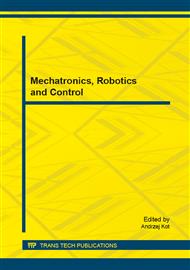[1]
R.B. Salter, Continuous Passive Motion: From Origination to Research to Clinical Applications. The Journal of Rheumatology Volume 31, no. 11, (2004).
Google Scholar
[2]
A. Zembaty,. Wydawnictwo Kasper, Kraków (2002).
Google Scholar
[3]
L. Brosseau, S. Milne, G.A. Wells, et al. Efficacy of continuous passive motion following total knee arthroplasty: a metaanalysis. J. Rheumatol 2004; 31: 2251-64.
Google Scholar
[4]
M. Kandyba, A. Żurowska, The design and performance of passive devices with physiotherapy exercises of the upper and lower limbs (thesis; topic authors and supervisors: Dominik I., Dwornicka R. ) AGH, (2012).
Google Scholar
[5]
I. Dominik, S. Flaga, B. Karwat, Y. Shalapko, Conception of 3D Scanner Applied to Surface Digital Recording of Rock Mass Experimental Modeling. Polish Journal of Environmental Studies Volume: 23, Issue: 3, pp.989-993, (2014).
Google Scholar
[6]
I. Dominik, M. Iwaniec, Ł. Lech, Low frequency damage analysis of electric pylon model by fuzzy logic application. Journal of Low Frequency Noise Vibration and Active Control, ISSN 1461-3484. vol. 32 no. 3, (2013) 239–249.
DOI: 10.1260/0263-0923.32.3.239
Google Scholar
[7]
J. Wołoszyn, A. Gołaś, Modelling of a borehole heat exchanger using a finite element with multiple degrees of freedom. Geothermics; ISSN 0375-6505. 2013 vol. 47, s. 13–26.
DOI: 10.1016/j.geothermics.2013.01.002
Google Scholar
[8]
T. Śliwa, A. Gołaś, J. Wołoszyn, A. Gonet, Numerical model of borehole heat exchanger in ANSYS CFX software. Archives of Mining Sciences; ISSN 0860-7001. 2012 vol. 57 no. 2, s. 375–390.
DOI: 10.2478/v10267-012-0024-3
Google Scholar
[9]
R. Dwornicka, The Impact of the Power Plant Unit Start-Up Scheme on the Pollution Load, Advanced Materials Research, Volume: 874 (2014), 63-69.
DOI: 10.4028/www.scientific.net/amr.874.63
Google Scholar
[10]
J. Kwasniewski, I. Dominik, The SMA Wires Application in the Braille Monitor. Solid State Phenomena, volume 165, 2010. pp.290-293.
DOI: 10.4028/www.scientific.net/ssp.165.290
Google Scholar
[11]
G. Olszyna, A. Sioma, A. Tytko, Laser Measurement System For The Diagnostics Of Mine Hoist Components. Archives of Mining Sciences Volume: 59 Issue: 2 Pages: 337-346. (2014).
DOI: 10.2478/amsc-2014-0024
Google Scholar
[12]
Sioma A. The estimation of resolution in 3D range image system. Proceedings of the 2013 14th International Carpathian Control Conference (ICCC). Pages: 346-349. (2013).
DOI: 10.1109/carpathiancc.2013.6560567
Google Scholar
[13]
N. C. Mascarin, R. L. Vancini, M. dos Santos Andrade et. al., Effects of kinesiotherapy, ultrasound and electrotherapy in management of bilateral knee osteoarthritis: prospective clinical trial. BMC Musculoskeletal Disorders (2012).
DOI: 10.1186/1471-2474-13-182
Google Scholar


